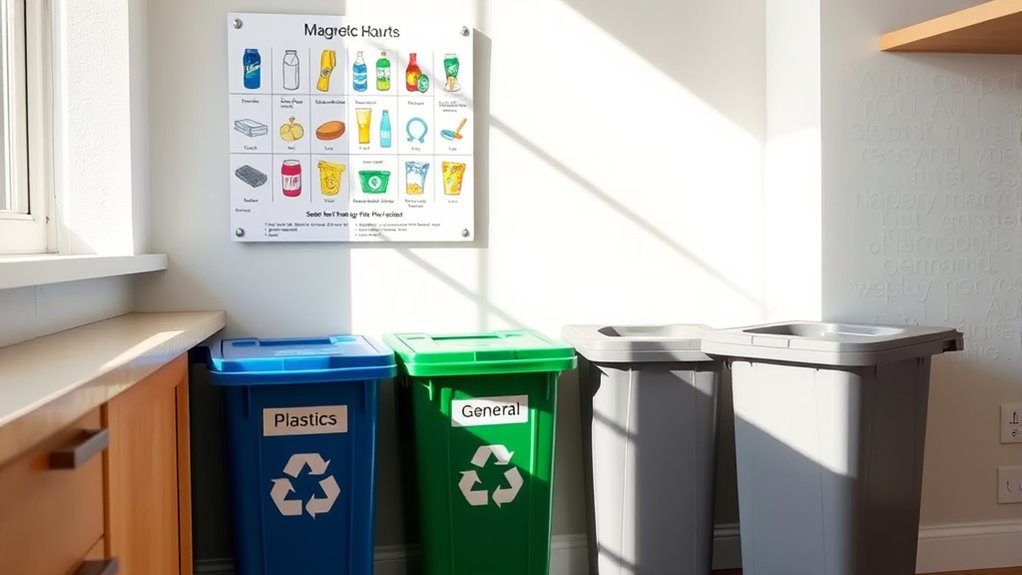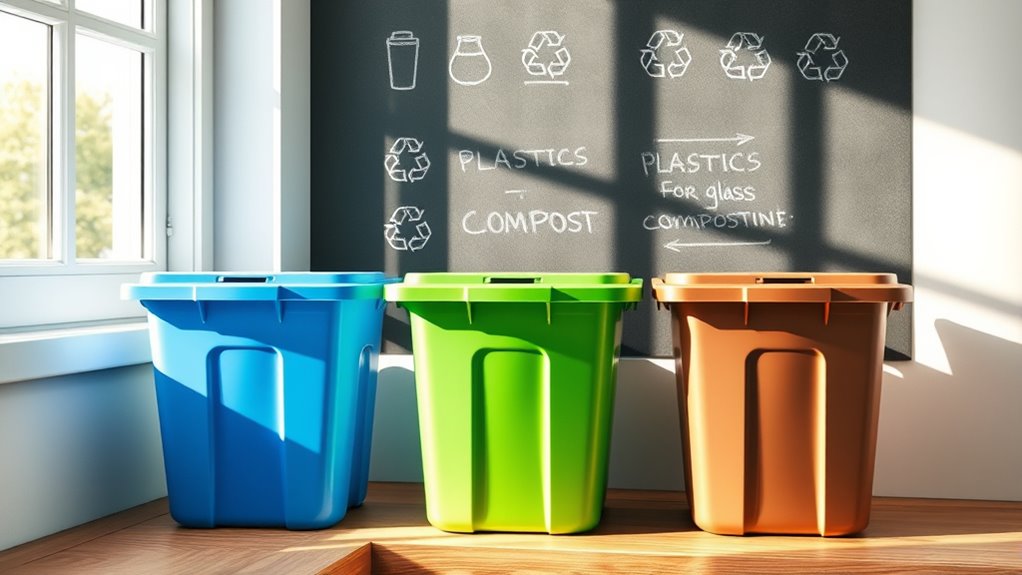To set up a home recycling system, start by creating clearly labeled bins for different recyclables like plastics, paper, and metals. Familiarize yourself with your local recycling guidelines to guarantee proper sorting. Place the bins in accessible areas, such as the kitchen or garage, and encourage your household to reuse and repair items before discarding. Organizing your waste this way reduces contamination and waste. Keep exploring to learn easy ways to improve your recycling habits and make a bigger impact.
Key Takeaways
- Identify local recycling guidelines and accepted materials to ensure proper sorting.
- Designate clearly labeled bins for different recyclables, such as plastics, paper, and metals.
- Place recycling bins in accessible, convenient locations to encourage consistent use.
- Rinse and clean recyclables to prevent contamination and odors.
- Educate household members about recycling practices to promote ongoing participation.

Setting up a home recycling system is a practical step toward reducing waste and protecting the environment. It’s not just about sorting your recyclables; it’s about creating habits that make a real difference. One of the best ways to do this is by understanding composting basics. Composting allows you to turn organic waste, like food scraps and yard waste, into nutrient-rich soil for your garden. It’s a straightforward process that reduces the amount of trash going to landfills and minimizes methane emissions, a potent greenhouse gas. To start, designate a compost bin in your backyard or even in a convenient indoor space if you have limited outdoor room. Fill it with a mix of green materials, such as vegetable peels and coffee grounds, and brown materials like leaves and cardboard. Remember to turn the compost regularly to aerate it, speeding up decomposition and preventing odors. This simple addition to your waste management routine helps cut down on organic waste sent to landfills and promotes healthy plant growth in your garden.
In addition, understanding the importance of contrast ratio in projectors can help you select the best equipment for your home environment, ensuring optimal picture quality and viewing experience.
Next, focus on reducing plastic waste, which is a major component of household trash and a considerable environmental concern. To do this effectively, start by evaluating your current plastic consumption. Opt for reusable bags, bottles, and containers instead of single-use plastics. When shopping, choose products with minimal or no plastic packaging, and consider buying in bulk to cut down on unnecessary wrappers. Educate yourself about which plastics are recyclable in your area and set up clearly labeled bins for them. Keep in mind that not all plastics are recyclable, so familiarizing yourself with local guidelines can prevent contamination of your recycling stream. Avoid plastic items that are difficult to recycle or that end up in landfills quickly, such as certain clamshell containers or produce bags, by switching to eco-friendly alternatives like glass, metal, or compostable packaging. Over time, these choices will appreciably reduce your plastic waste footprint. Incorporate habits like reusing packaging when possible and repairing broken items instead of discarding them. These practices not only lessen the amount of plastic waste you generate but also encourage a more sustainable lifestyle.
Frequently Asked Questions
What Types of Materials Are Accepted in Local Recycling Programs?
You want to know what materials are accepted in local recycling programs. Recycling regulations vary, so it’s important to verify your area’s rules. Generally, you can recycle paper, cardboard, plastics labeled with recycling symbols, glass bottles, and metal cans. Proper material sorting helps, so separate recyclables correctly. Avoid contaminated items like greasy pizza boxes or plastic bags, which aren’t accepted. Following these guidelines ensures your recycling efforts are effective and compliant.
How Often Should I Empty My Recycling Bins?
You should empty your recycling bins regularly, ideally once a week, to prevent overflow and odors. Proper recycling bin placement near your kitchen or laundry area makes it convenient to use consistently. Also, consider incorporating composting tips, like adding food scraps to a compost bin, to reduce waste. Regularly checking and cleaning your bins keeps your recycling system efficient and helps maintain a clean, eco-friendly home environment.
Are There Specific Containers Recommended for Different Recyclables?
Think of it as hitting two birds with one stone—you want your recycling container types to be practical and organized. Using separate containers for plastics, paper, and metals keeps things tidy and makes recycling easier. Container organization tips include labeling each bin clearly and choosing durable, stackable options. This way, you won’t be chasing your tail trying to sort everything at the last minute, and your recycling process becomes a breeze.
How Can I Motivate Family Members to Participate Consistently?
You can motivate your family to participate consistently by encouraging family involvement and establishing reward systems. Make recycling fun and rewarding by recognizing everyone’s efforts, maybe with small incentives or praise. Explain the environmental benefits and how their participation makes a difference. Keep the process simple and accessible. When everyone feels included and appreciated, they’re more likely to stay engaged and develop recycling habits that last.
What Are Common Mistakes to Avoid in Home Recycling?
Think recycling myths are just funny stories? Think again! Avoid common mistakes like mixing recyclables with compostables or ignoring composting tips. You might think you’re helping, but you could be contaminating the entire bin. Stay informed and educate your family. Remember, proper sorting saves time and resources. Don’t be the household legend for recycling blunders—know what to do and what to avoid for a greener home.
Conclusion
Setting up a home recycling system is like planting a seed that grows into a greener future. With a little effort, you turn your daily habits into a thriving garden of sustainability. Keep it simple, stay consistent, and watch your efforts blossom into positive change. Remember, each small step you take is a brushstroke in the masterpiece of environmental stewardship. Together, you and your system can make a lasting impact, one piece of recyclable waste at a time.








